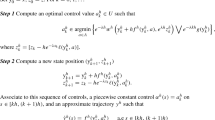Abstract
A method of designing control inputs for tracking problems when models considered in the form of stochastic differential equations is proposed. Using the ideas of control vector parameterization, the control input identification problem is formulated as a parameter identification problem, which is solved using homotopy optimization. To further obtain a control with the least number of switchings, i.e., minimum attention control, a sparse recovery framework is developed. The accuracy of the proposed methods is demonstrated with the help of a linear second-order system and a non-linear quadruple tank system.





Similar content being viewed by others
Notes
In a more general case, there might be amplitude constraints on the states and inputs, which are not considered in the current work.
Though the example 1 considers systems with noise in all the states, the same approach will work for systems with degenerate K i.e., where in noise appears only in some of the state equations as considered in [26].
References
Biegler LT (2010) Nonlinear programming: concepts, algorithms, and applications to chemical processes. Soc Ind Appl Math, Philadelphia
Kirk DE (2004) Optimal control theory: an introduction, Dover Publications, New York
Schlegel M, Stockmann K, Binder T, Marquardt W (2005) Dynamic optimization using adaptive control vector parameterization. Comput Chem Eng 29(8):1731–1751
Kraft D (1985) On converting optimal control problems into nonlinear programming problems. In: Schittkowski K (ed) Computational mathematical programming. Springer, Berlin, pp 261–280
Binder T, Cruse A, Villar CC, Marquardt W (2000) Dynamic optimization using a wavelet based adaptive control vector parameterization strategy. Comput Chem Eng 24(2–7):1201–1207
Bock HG, Plitt KJ (1984) A multiple shooting algorithm for direct solution of optimal control problems. IFAC Proc Vol 17(2):1603–1608
Cuthrell JE, Biegler LT (1987) On the optimization of differential-algebraic process systems. AIChE J 33(8):1257–1270
Anderson BD, Moore JB (2007) Optimal control: linear quadratic methods. Dover Publications, New York
Athans M (1963) Minimum-fuel feedback control systems: second-order case. IEEE Trans Appl Ind 82(65):8–17
Brockett W (1997) Minimum attention control. In: IEEE Conference on Decision and Control, vol 3, pp 2628–2632
Nagahara M, Quevedo DE, Nesic D et al (2016) Maximum hands-off control: a paradigm of control effort minimization. IEEE Trans Autom Control 61(3):735–747
Øksendal B (2000) Stochastic differential equations: an introduction with applications, Springer, New York
Vyasarayani CP, Uchida T, Carvalho A, McPhee J (2011) Parameter identification in dynamic systems using the homotopy optimization approach. Multibody Syst Dyn 26(4):411–424
Dunlavy DM, Klimov D, Thirumalai D, O’leary DP (2005) Hope: a homotopy optimization method for protein structure prediction. J Comput Biol 12(10):1275–1288
Vyasarayani CP, Uchida T, McPhee J (2012) Single-shooting homotopy method for parameter identification in dynamical systems. Phys Rev E 85(3):036201
Khalil H (1999) High-gain observers in nonlinear feedback control. Lect Notes Control Inform Sci 244:249–268
Vyasarayani CP, Uchida T, McPhee J (2012) Nonlinear parameter identification in multibody systems using homotopy continuation. J Comput Nonlinear Dyn 7(1):011012
Ramsay JO, Hooker G, Campbell D, Cao J (2007) Parameter estimation for differential equations: a generalized smoothing approach. J Royal Stat Soc: Series B (Stat Methodol) 69(5):741–796
Garnier H, Mensler M, Richard A (2003) Continuous-time model identification from sampled data: implementation issues and performance evaluation. Int J Control 76:1337–1357
Johansson KH (2000) The quadruple-tank process: a multivariable laboratory process with an adjustable zero. IEEE Trans Control Syst Technol 8(3):456–465
Vadigepalli R, Gatzke EP, Doyle FJ (2001) Robust control of a multivariable experimental four-tank system. Ind Eng Chem Res 40(8):1916–1927
Avriel M (2003) Nonlinear programming: analysis and methods. Dover Publications, New York
Zhang Q (1997) Using wavelet network in nonparametric estimation. IEEE Trans Neural Netw 8(2):227–236
Billings SA, Wei HL (2005) A new class of wavelet networks for nonlinear system identification. IEEE Trans Neural Netw 16(4):862–874
Higham DJ (2001) An algorithmic introduction to numerical simulation of stochastic differential equations. SIAM Rev 43(3):525–546
Iourtchenko D (2009) Solution to a class of stochastic lq problems with bounded control. Automatica 45(6):1439–1442
Author information
Authors and Affiliations
Corresponding author
Ethics declarations
Conflict of interest
The authors have no competing interests to declare.
Rights and permissions
About this article
Cite this article
Varanasi, S.K., Jampana, P. & Vyasarayani, C.P. Minimum attention stochastic control with homotopy optimization. Int. J. Dynam. Control 9, 266–274 (2021). https://doi.org/10.1007/s40435-020-00639-6
Received:
Revised:
Accepted:
Published:
Issue Date:
DOI: https://doi.org/10.1007/s40435-020-00639-6




